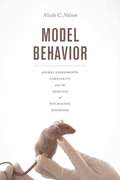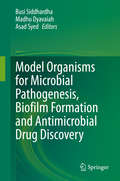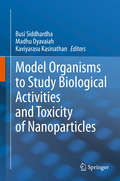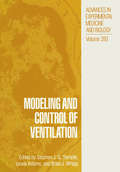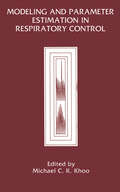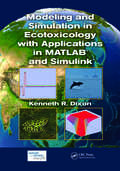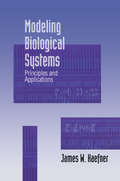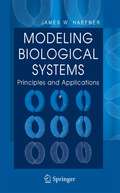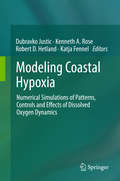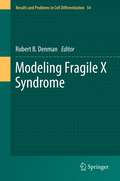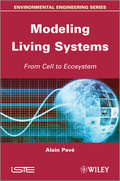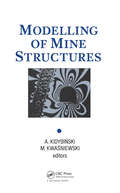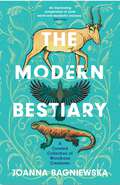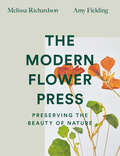- Table View
- List View
Model Behavior: Animal Experiments, Complexity, and the Genetics of Psychiatric Disorders
by Nicole C. NelsonMice are used as model organisms across a wide range of fields in science today—but it is far from obvious how studying a mouse in a maze can help us understand human problems like alcoholism or anxiety. How do scientists convince funders, fellow scientists, the general public, and even themselves that animal experiments are a good way of producing knowledge about the genetics of human behavior? In Model Behavior, Nicole C. Nelson takes us inside an animal behavior genetics laboratory to examine how scientists create and manage the foundational knowledge of their field. Behavior genetics is a particularly challenging field for making a clear-cut case that mouse experiments work, because researchers believe that both the phenomena they are studying and the animal models they are using are complex. These assumptions of complexity change the nature of what laboratory work produces. Whereas historical and ethnographic studies traditionally portray the laboratory as a place where scientists control, simplify, and stabilize nature in the service of producing durable facts, the laboratory that emerges from Nelson’s extensive interviews and fieldwork is a place where stable findings are always just out of reach. The ongoing work of managing precarious experimental systems means that researchers learn as much—if not more—about the impact of the environment on behavior as they do about genetics. Model Behavior offers a compelling portrait of life in a twenty-first-century laboratory, where partial, provisional answers to complex scientific questions are increasingly the norm.
Model Behavior: Animal Experiments, Complexity, and the Genetics of Psychiatric Disorders
by Nicole C. NelsonMice are used as model organisms across a wide range of fields in science today—but it is far from obvious how studying a mouse in a maze can help us understand human problems like alcoholism or anxiety. How do scientists convince funders, fellow scientists, the general public, and even themselves that animal experiments are a good way of producing knowledge about the genetics of human behavior? In Model Behavior, Nicole C. Nelson takes us inside an animal behavior genetics laboratory to examine how scientists create and manage the foundational knowledge of their field. Behavior genetics is a particularly challenging field for making a clear-cut case that mouse experiments work, because researchers believe that both the phenomena they are studying and the animal models they are using are complex. These assumptions of complexity change the nature of what laboratory work produces. Whereas historical and ethnographic studies traditionally portray the laboratory as a place where scientists control, simplify, and stabilize nature in the service of producing durable facts, the laboratory that emerges from Nelson’s extensive interviews and fieldwork is a place where stable findings are always just out of reach. The ongoing work of managing precarious experimental systems means that researchers learn as much—if not more—about the impact of the environment on behavior as they do about genetics. Model Behavior offers a compelling portrait of life in a twenty-first-century laboratory, where partial, provisional answers to complex scientific questions are increasingly the norm.
Model Behavior: Animal Experiments, Complexity, and the Genetics of Psychiatric Disorders
by Nicole C. NelsonMice are used as model organisms across a wide range of fields in science today—but it is far from obvious how studying a mouse in a maze can help us understand human problems like alcoholism or anxiety. How do scientists convince funders, fellow scientists, the general public, and even themselves that animal experiments are a good way of producing knowledge about the genetics of human behavior? In Model Behavior, Nicole C. Nelson takes us inside an animal behavior genetics laboratory to examine how scientists create and manage the foundational knowledge of their field. Behavior genetics is a particularly challenging field for making a clear-cut case that mouse experiments work, because researchers believe that both the phenomena they are studying and the animal models they are using are complex. These assumptions of complexity change the nature of what laboratory work produces. Whereas historical and ethnographic studies traditionally portray the laboratory as a place where scientists control, simplify, and stabilize nature in the service of producing durable facts, the laboratory that emerges from Nelson’s extensive interviews and fieldwork is a place where stable findings are always just out of reach. The ongoing work of managing precarious experimental systems means that researchers learn as much—if not more—about the impact of the environment on behavior as they do about genetics. Model Behavior offers a compelling portrait of life in a twenty-first-century laboratory, where partial, provisional answers to complex scientific questions are increasingly the norm.
Model Organisms for Microbial Pathogenesis, Biofilm Formation and Antimicrobial Drug Discovery
by Busi Siddhardha Madhu Dyavaiah Asad SyedThis book provides essential insights into microbial pathogenesis, host-pathogen interactions, and the anti-microbial drug resistance of various human pathogens on the basis of various model organisms. The initial sections of the book introduce readers to the mechanisms of microbial pathogenesis, host-pathogen interactions, anti-microbial drug resistance, and the dynamics of biofilm formation. Due to the emergence of various microbial resistant strains, it is especially important to understand the prognosis for microbial infections, disease progression profiles, and mechanisms of resistance to antibiotic therapy in order to develop novel therapeutic strategies. In turn, the second part of the book presents a comparative analysis of various animal models to help readers understand microbial pathogenesis, host-pathogen interactions, anti-microbial drug discovery, anti-biofilm therapeutics, and treatment regimes. Given its scope, the book represents a valuable asset for microbiologists, biotechnologists, medical professionals, drug development researchers, and pharmacologists alike.
Model Organisms to Study Biological Activities and Toxicity of Nanoparticles
by Busi Siddhardha Madhu Dyavaiah Kaviyarasu KasinathanThis book provides a comprehensive overview of state-of-the-art applications of nanotechnology in biology and medicine, as well as model organisms that can help us understand the biological activity and associated toxicity of nanoparticles, and devise strategies to minimize toxicity and enhance therapies. Thanks to their high surface-to-volume ratio, nanoparticles are characterized by excellent biocompatibility and bioavailability, a high therapeutic index, and relatively low toxicity, which has led to their widespread application in the early diagnosis of diseases, comprehensive monitoring of disease progression, and improved therapeutics. The book also explores nanoparticle-based insecticides and their mechanisms of action, and provides a comparative analysis of the various model organisms that are used to understand the biological properties of nanoparticles. Further, it describes various in-vivo models that yield important insights into nanomaterial-mediated toxicity, promoting the optimal utilization of nanoparticles. In closing, the book discusses future perspectives and regulatory issues concerning the use of nanomaterials in translational research.
Modeling and Control of Ventilation (Advances in Experimental Medicine and Biology #393)
by Stephen J. G. Semple Lewis Adams Brian J. WhippThe origins of what have come to be known as the "Oxford" Conferences on modelling and the control of breathing can be traced back to a discussion between Dan Cunningham and Richard Hercynski at a conference dinner at the Polish Academy of Sciences in 1971. Each felt that they had benefited from the different perspectives from which the topic of ventilatory control was approached - predominantly physiological in the case of Dr Cunningham and predominantly mathematical in the case of Dr Hercynski. Their judgement at that time was that a conference on the control of breathing which allowed investigators with these different (but related) scientific perspectives to present and discuss their work, might prove fruitful. We would judge that this has amply been borne out, based upon the success of the series of conferences which resulted from that seminal dinner conversation. The first conference, entitled "Modelling of a Biological Control System: The Regulation of Breathing" was held in Oxford, UK, in 1978. Subsequent conferences were: "Modelling and the Control of Breathing" at Lake Arrowhead, California, in 1982; "Con cepts and Formulations in the Control of Breathing" in Solignac, France, in 1985; "Respi ratory Control: A Modeling Perspective" at Grand Lakes, Colorado, in 1988; and "Control of Breathing and Its Modelling Persepctive" at the Fuji Institute in Japan in 1991. The conferences, subsequent to the one in Oxford, have all resulted in well-received published proceedings.
Modeling and Parameter Estimation in Respiratory Control
by M. C. K. KhooExperimentalists tend to revel in the complexity and multidimensionality of biological processes. Modelers, on the other hand, generally look towards parsimony as a guiding prin ciple in their approach to understanding physiological systems. It is therefore not surprising that a substantial degree of miscommunication and misunderstanding still exists between the two groups of truth-seekers. However, there have been numerous instances in physiology where the marriage of mathematical modeling and experimentation has led to powerful in sights into the mechanisms being studied. Respiratory control represents one area in which this kind of cross-pollination has proven particularly fruitful. While earlier modeling ef forts were directed primarily at the chemical control of ventilation, more recent studies have extended the scope of modeling to include the neural and mechanical aspects pertinent to respiratory control. As well, there has been a greater awareness of the need to incorpo rate interactions with other organ systems. Nevertheless, it is necessary from time to time to remind experimentalists of the existence of modelers, and vice versa. The 4th Annual Biomedical Simulations Resource (BMSR) Short Course was held in Marina Del Rey on May 21-22,1989, to acquaint respiratory physiologists and clinical researchers with state-of-the art methodologies in mathematical modeling, experiment design and data analysis, as well as to provide an opportunity for experimentalists to challenge modelers with their more recent findings.
Modeling and Simulation in Ecotoxicology with Applications in MATLAB and Simulink
by Kenneth R. DixonExploring roles critical to environmental toxicology, Modeling and Simulation in Ecotoxicology with Applications in MATLAB and Simulink covers the steps in modeling and simulation from problem conception to validation and simulation analysis. Using the MATLAB and Simulink programming languages, the book presents examples of mathematical functions a
Modeling Biological Systems: Principles and Applications
by James W. HaefnerThis book is intended as a text for a first course on creating and analyzing computer simulation models of biological systems. The expected audience for this book are students wishing to use dynamic models to interpret real data mueh as they would use standard statistical techniques. It is meant to provide both the essential principles as well as the details and equa tions applicable to a few particular systems and subdisciplines. Biological systems, however, encompass a vast, diverse array of topics and problems. This book discusses only a select number of these that I have found to be useful and interesting to biologists just beginning their appreciation of computer simulation. The examples chosen span classical mathematical models of well-studied systems to state-of-the-art topics such as cellular automata and artificial life. I have stressed the relationship between the models and the biology over mathematical analysis in order to give the reader a sense that mathematical models really are useful to biologists. In this light, I have sought examples that address fundamental and, I think, interesting biological questions. Almost all of the models are directly COIIl pared to quantitative data to provide at least a partial demonstration that some biological models can accurately predict.
Modeling Biological Systems: Principles and Applications
by James W. HaefnerI Principles 1 1 Models of Systems 3 1. 1 Systems. Models. and Modeling . . . . . . . . . . . . . . . . . . . . 3 1. 2 Uses of Scientific Models . . . . . . . . . . . . . . . . . . . . . . . . 4 1. 3 Example: Island Biogeography . . . . . . . . . . . . . . . . . . . . . 6 1. 4 Classifications of Models . . . . . . . . . . . . . . . . . . . . . . . . 10 1. 5 Constraints on Model Structure . . . . . . . . . . . . . . . . . . . . . 12 1. 6 Some Terminology . . . . . . . . . . . . . . . . . . . . . . . . . . . 12 1. 7 Misuses of Models: The Dark Side . . . . . . . . . . . . . . . . . . . 13 1. 8 Exercises . . . . . . . . . . . . . . . . . . . . . . . . . . . . . . . . 15 2 The Modeling Process 17 2. 1 Models Are Problems . . . . . . . . . . . . . . . . . . . . . . . . . . 17 2. 2 Two Alternative Approaches . . . . . . . . . . . . . . . . . . . . . . 18 2. 3 An Example: Population Doubling Time . . . . . . . . . . . . . . . . 24 2. 4 Model Objectives . . . . . . . . . . . . . . . . . . . . . . . . . . . . 28 2. 5 Exercises . . . . . . . . . . . . . . . . . . . . . . . . . . . . . . . . 30 3 Qualitative Model Formulation 32 3. 1 How to Eat an Elephant . . . . . . . . . . . . . . . . . . . . . . . . . 32 3. 2 Forrester Diagrams . . . . . . . . . . . . . . . . . . . . . . . . . . . 33 3. 3 Examples . . . . . . . . . . . . . . . . . . . . . . . . . . . . . . . . 36 3. 4 Errors in Forrester Diagrams . . . . . . . . . . . . . . . . . . . . . . 44 3. 5 Advantages and Disadvantages of Forrester Diagrams . . . . . . . . . 44 3. 6 Principles of Qualitative Formulation . . . . . . . . . . . . . . . . . . 45 3. 7 Model Simplification . . . . . . . . . . . . . . . . . . . . . . . . . . 47 3. 8 Other Modeling Problems . . . . . . . . . . . . . . . . . . . . . . . . 49 viii Contents . . . . . . . . . . . . . . . . . . . . . . . . . . . . . . . . 3. 9 Exercises 53 4 Quantitative Model Formulation: I 4. 1 From Qualitative to Quantitative . . . . . . . . . . . . . . . . . Finite Difference Equations and Differential Equations 4. 2 . . . . . . . . . . . . . . . . 4. 3 Biological Feedback in Quantitative Models . . . . . . . . . . . . . . . . . . . . . . . . . . 4. 4 Example Model . . . . . . . . . . . . . . . . . . . . . . . . . . . . . 4. 5 Exercises 5 Quantitative Model Formulation: I1 81 . . . . . . . . . . . . . . . . . . . . . . . . . . . 5. 1 Physical Processes 81 . . . . . . . . . . . . . . . 5. 2 Using the Toolbox of Biological Processes 89 . . . . . . . . . . . . . . . . . . . . . . . . . . . . 5. 3 Useful Functions 96 . . . . . . . . . . . . . . . . . . . . . . . . . . . . . . . . 5. 4 Examples 102 . . . . . . . . . . . . . . . . . . . . . . . . . . . . . . . . 5. 5 Exercises 104 6 Numerical Techniques 107 . . . . . . . . . . . . . . . . . . . . . . . 6. 1 Mistakes Computers Make 107 . . . . . . . . . . . . . . . . . . . . . . . . . . 6. 2 Numerical Integration 110 . . . . . . . . . . . . . . . . 6. 3 Numerical Instability and Stiff Equations 115 . . . . . . . . . . . . . .
Modeling Coastal Hypoxia: Numerical Simulations of Patterns, Controls and Effects of Dissolved Oxygen Dynamics
by Dubravko Justic Kenneth A. Rose Robert D. Hetland Katja FennelThis book provides a snapshot of representative modeling analyses of coastal hypoxia and its effects. Hypoxia refers to conditions in the water column where dissolved oxygen falls below levels that can support most metazoan marine life (i.e., 2 mg O2 l-1). The number of hypoxic zones has been increasing at an exponential rate since the 1960s; there are currently more than 600 documented hypoxic zones in the estuarine and coastal waters worldwide. Hypoxia develops as a synergistic product of many physical and biological factors that affect the balance of dissolved oxygen in seawater, including temperature, solar radiation, wind, freshwater discharge, nutrient supply, and the production and decay of organic matter. A number of modeling approaches have been increasingly used in hypoxia research, along with the more traditional observational and experimental studies. Modeling is necessary because of rapidly changing coastal circulation and stratification patterns that affect hypoxia, the large spatial extent over which hypoxia develops, and limitations on our capabilities to directly measure hypoxia over large spatial and temporal scales. This book consists of 15 chapters that are broadly organized around three main topics: (1) Modeling of the physical controls on hypoxia, (2) Modeling of biogeochemical controls and feedbacks, and, (3) Modeling of the ecological effects of hypoxia. The final chapter is a synthesis chapter that draws generalities from the earlier chapters, highlights strengths and weaknesses of the current state-of-the-art modeling, and offers recommendations on future directions.
Modeling Fragile X Syndrome (Results and Problems in Cell Differentiation #54)
by Robert B. DenmanIntroduction.-Probing Astrocyte Function in Fragile X Syndrome.- Neural Stem Cells.- Fragile X Mental Retardation Protein (FMRP) and the Spinal Sensory System.– The Role of the Postsynaptic Density in the Pathology of the Fragile X Syndrome.- Behavior in a Drosophila model of Fragile X.- Molecular and Genetic Analysis of the Drosophila Model of Fragile X Syndrome.- Fragile X Mental Retardation Protein and Stem Cells.- Manipulating the Fragile X Mental Retardation Proteins in the Frog.- Exploring the Zebra finch Taeniopygia gutta as a Novel Animal Model for the Speech-language Deficit of Fragile X Syndrome.- Neuroendocrine Alterations in the Fragile X Mouse.- Taking STEPs forward to understanding Fragile X Syndrome.- Fmr-1 as an Offspring Genetic and a Maternal Environmental Factor in Neurodevelopmental Disease.- Mouse Models of the Fragile X Premutation and the Fragile X Associated Tremor/Ataxia Syndrome.- Clinical Aspects of the Fragile X Syndrome.- Fragile X Syndrome: A Psychiatric Perspective.- Fragile X Syndrome and Targeted Treatment Trials.- The Fragile X-associate Tremor Ataxia Syndrome.- Vignettes: Models in Absentia.
Modeling of Living Systems: From Cell to Ecosystem
by Alain PavéModeling is now one of the most efficient methodologies in life sciences. From practice to theory, this book develops this approach illustrated by many examples; general concepts and the current state of the art are also presented and discussed. An historical and general introduction informs the reader how mathematics and formal tools are used to solve biological problems at all levels of the organization of life. The core of this book explains how this is done, based on practical examples coming, for the most part, from the author’s personal experience. In most cases, data are included so that the reader can follow the reasoning process and even reproduce calculus. The final chapter is devoted to essential concepts and current developments. The main mathematical tools are presented in an appendix to the book and are written in an adapted language readable by scientists, professionals or students, with a basic knowledge of mathematics.
Modeling of Living Systems: From Cell to Ecosystem
by Alain PavéModeling is now one of the most efficient methodologies in life sciences. From practice to theory, this book develops this approach illustrated by many examples; general concepts and the current state of the art are also presented and discussed. An historical and general introduction informs the reader how mathematics and formal tools are used to solve biological problems at all levels of the organization of life. The core of this book explains how this is done, based on practical examples coming, for the most part, from the author’s personal experience. In most cases, data are included so that the reader can follow the reasoning process and even reproduce calculus. The final chapter is devoted to essential concepts and current developments. The main mathematical tools are presented in an appendix to the book and are written in an adapted language readable by scientists, professionals or students, with a basic knowledge of mathematics.
Modeling Phase Transitions in the Brain (Springer Series in Computational Neuroscience #4)
by D. Alistair Steyn-Ross Moira Steyn-RossForeword by Walter J. Freeman. The induction of unconsciousness using anesthetic agents demonstrates that the cerebral cortex can operate in two very different behavioral modes: alert and responsive vs. unaware and quiescent. But the states of wakefulness and sleep are not single-neuron properties---they emerge as bulk properties of cooperating populations of neurons, with the switchover between states being similar to the physical change of phase observed when water freezes or ice melts. Some brain-state transitions, such as sleep cycling, anesthetic induction, epileptic seizure, are obvious and detected readily with a few EEG electrodes; others, such as the emergence of gamma rhythms during cognition, or the ultra-slow BOLD rhythms of relaxed free-association, are much more subtle. The unifying theme of this book is the notion that all of these bulk changes in brain behavior can be treated as phase transitions between distinct brain states. Modeling Phase Transitions in the Brain contains chapter contributions from leading researchers who apply state-space methods, network models, and biophysically-motivated continuum approaches to investigate a range of neuroscientifically relevant problems that include analysis of nonstationary EEG time-series; network topologies that limit epileptic spreading; saddle--node bifurcations for anesthesia, sleep-cycling, and the wake--sleep switch; prediction of dynamical and noise-induced spatiotemporal instabilities underlying BOLD, alpha-, and gamma-band Hopf oscillations, gap-junction-moderated Turing structures, and Hopf-Turing interactions leading to cortical waves.
Modeling, Simulation and Visual Analysis of Crowds: A Multidisciplinary Perspective (The International Series in Video Computing #11)
by Saad Ali, Ko Nishino, Dinesh Manocha and Mubarak ShahOver the last several years there has been a growing interest in developing computational methodologies for modeling and analyzing movements and behaviors of ‘crowds' of people. This interest spans several scientific areas that includes Computer Vision, Computer Graphics, and Pedestrian Evacuation Dynamics. Despite the fact that these different scientific fields are trying to model the same physical entity (i.e. a crowd of people), research ideas have evolved independently. As a result each discipline has developed techniques and perspectives that are characteristically their own. The goal of this book is to provide the readers a comprehensive map towards the common goal of better analyzing and synthesizing the pedestrian movement in dense, heterogeneous crowds. The book is organized into different parts that consolidate various aspects of research towards this common goal, namely the modeling, simulation, and visual analysis of crowds. Through this book, readers will see the common ideas and vision as well as the different challenges and techniques, that will stimulate novel approaches to fully grasping “crowds."
Modelling Insect Populations in Agricultural Landscapes (Entomology in Focus #8)
by Rafael A. Moral Wesley A. C. GodoyThis book combines chapters emphasising mathematical, statistical, and computational modelling applied to insect populations, particularly pests or natural enemies in agricultural landscapes. There is a gap between agricultural pest experimentation and ecological theory, which requires a connection to supply models with laboratory, and field estimates and projects receiving inputs and insights from models. In addition, decision-making in entomology with respect to pest management and biological conservation of natural enemies has been supported by results obtained from different computational and mathematical approaches. This book brings contemporary issues related to optimization in spatially structured landscapes, insect movement, stability analysis, game theory, machine learning, computer vision, Bayesian modelling, as well as other frameworks.
Modelling of Mine Structures: Proceedings of the 10th plenary session of the International Bureau of Strata Mechanics, World Mining Congress, Stockholm, 4 June 1987
by A.KIDYBIŃSKI; M.KWAŚNIEWSKIProceedings of the 10th Plenary Scientific Session of the International Bureau of Strata Mechanics, World Mining Congress, Stockholm, June 1987.
Modelling of Mine Structures: Proceedings of the 10th plenary session of the International Bureau of Strata Mechanics, World Mining Congress, Stockholm, 4 June 1987
by A. KidybinskiProceedings of the 10th Plenary Scientific Session of the International Bureau of Strata Mechanics, World Mining Congress, Stockholm, June 1987.
Modellorganismen
by Peter Nick Reinhard Fischer Dietmar Gradl Mathias Gutmann Jörg Kämper Tilman Lamparter Michael RiemannDieses Buch vermittelt ein Verständnis dafür, was Modellorganismen sind, und warum sie für die Biologie eine so wichtige Rolle spielen. Im Zentrum steht, welche grundsätzlichen Ansätze mit Modellorganismen verfolgt werden und welche Limitierungen man beachten muss. Einige Modellorganismen werden exemplarisch anhand von übersichtlichen Steckbriefen vorgestellt und ihre Anwendung wird ausführlich diskutiert. Es werden außerdem wichtige wissenschaftstheoretische Grundlagen und Grundsätze der Biologie eingehend erörtert. Dieses Buch richtet sich vor allem an Studierende im fortgeschrittenen Bachelor und im Masterbereich der Lebenswissenschaften.
Models of Neurons and Perceptrons: Selected Problems and Challenges (Studies in Computational Intelligence #770)
by Andrzej BieleckiThis book describes models of the neuron and multilayer neural structures, with a particular focus on mathematical models. It also discusses electronic circuits used as models of the neuron and the synapse, and analyses the relations between the circuits and mathematical models in detail. The first part describes the biological foundations and provides a comprehensive overview of the artificial neural networks. The second part then presents mathematical foundations, reviewing elementary topics, as well as lesser-known problems such as topological conjugacy of dynamical systems and the shadowing property. The final two parts describe the models of the neuron, and the mathematical analysis of the properties of artificial multilayer neural networks. Combining biological, mathematical and electronic approaches, this multidisciplinary book it useful for the mathematicians interested in artificial neural networks and models of the neuron, for computer scientists interested in formal foundations of artificial neural networks, and for the biologists interested in mathematical and electronic models of neural structures and processes.
Modern Applications of DNA Amplification Techniques: Problems and New Tools
by Dirk Lassner Barbara Pustowoit Arndt RolfsIn the ten years since the first publication on PCR (Saiki et al. , 1985), this in vitro method of nucleic acid replication and modification has grown to rival in popularity traditional microbiological, genetical und technical procedures for cloning, sequencing, gene detecting and related procedures. To date the PCR literature has emphasized six main areas of application: genetic mapping, detection of mutations, genetic polymorphism, transcriptional splicing and regulation, molecular virology and quantitative procedures. The overwhelming focus of quantification of DNA or RNA by PCR has been on human microbiology and oncological problems. The exquisite sensitivity of PCR gives this method the ability to detect extremely rare DNAs, mRNAs, mRNAs in small numbers of cells or in small amounts of tissue, and mRNAs expressed in mixed-cell populations. However, the exact and accurate quantification of specific nucleic acids in biological samples is in spite of numerous publications in that field still a general problem: during the peR process, an unknown initial number of target sequences are used as a template from which a large quantity of specific product can be obtained. Although the amount of product formed is easy to determine, it is difficult to deduce the initial copy number of the target molecule because the efficiency of the peR is largely unknown.
The Modern Bestiary: A Curated Collection of Wondrous Creatures
by Joanna Bagniewska'An illuminating compendium of some weird and wonderful creatures.' ObserverFrom the familiar to the improbable, the gross to the endearing, The Modern Bestiary is a compendium of curious creatures. It includes both animals that have made headlines and those you've probably never heard of, such as skin-eating caecilians, harp sponges, or zombie worms - also known as bone-eating snot flowers. Arranged by elements (Earth, Water, Air), The Modern Bestiary contains well-known species told from new, unexpected angles (rats that drive cars; fish that communicate by passing wind), as well as stranger and lesser-known creatures, including carnivorous mice that howl at the moon, cross-dressing cuttlefish, and antechinuses - small marsupials that literally mate themselves to death. Finally, there are the 'aliens on Earth' - the incredible, the surreal, the magical - such as tardigrades, tongue-eating lice and immortal jellyfish, creatures so astonishing that they make unicorns look rather commonplace.Written by a zoologist with a flair for storytelling, this is a fascinating celebration of the animal kingdom.' [A] beautifully written book to make you laugh, squirm and - perhaps most importantly - appreciate how lucky we are to not have to live inside an anus.' Yussef Rafik'The Modern Bestiary provides a fascinating, accessible and humorous insight into the wonders of the natural world.' Amy Dickman, director of Oxford University's Wildlife Conservation Research Unit 'If you love animals, especially ones with unsavoury habits, this book is for you. Entries are crafted with affection, cast-iron scholarship and an unyielding dedication to exposing as much hilarious weirdness as the animal kingdom can offer.' Tom Moorhouse, author of Elegy for a River'Everyone who loves wildlife - especially fantastically weird and cringingly gross wildlife - should read this masterful book.' Mark Carwardine, author/presenter of Last Chance to See'If ever there was a book that highlighted the bewildering wonders of the natural world, and the need for their conservation, this is it.' Michael Brooke, author of Far from Land
Modern Concepts in Penicillium and Aspergillus Classification (Nato Science Series A: #185)
by Robert A. Samson John I. PittIn our view, the First International Penicillium and Aspergillus Workshop held in Baarn and Amsterdam in May, 1985, was a great success. The assembly in one place of so many specialists in these two genera produced both interesting viewpoints and lively discussions. But more particularly, a remarkable cohesion of ideas emerged, borne primarily of the realisation that taxonomy has passed from the hands of the solitary morphologist. The future of taxonomy lay in collaborative and multidisciplinary studies embracing morphology, physiology and newer methodologies. Penicillium and Aspergillus Workshop was borne logically The Second International from the first, and was held in Baarn on May 8-12, 1989. It was attended by 38 scientists from 16 countries. At this Workshop we have attempted to move further into new methods, especially by bringing together molecular biologists, medical and food mycologists and biochemists as well as more traditional taxonomists. We feel that the meeting contributed greatly to dialogue between taxonomists, and also fundamental and applied mycologists. At the meeting, we became aware that the approach to taxonomy of these genera is now becoming more pragmatic, with an increasing emphasis on consensus, and on stability of names. This is a noteworthy development, which we, as editors, welcome. So many species in Penicillium and Aspergillus are economically important in biotechnology, foods and medicine, and practical, stable taxonomy is of vital importance. These Proceedings comprise 40 papers divided into 9 chapters.
The Modern Flower Press: Preserving The Beauty Of Nature
by Melissa Richardson Amy FieldingA contemporary, beautifully illustrated book on flowers, flower pressing and arranging.
